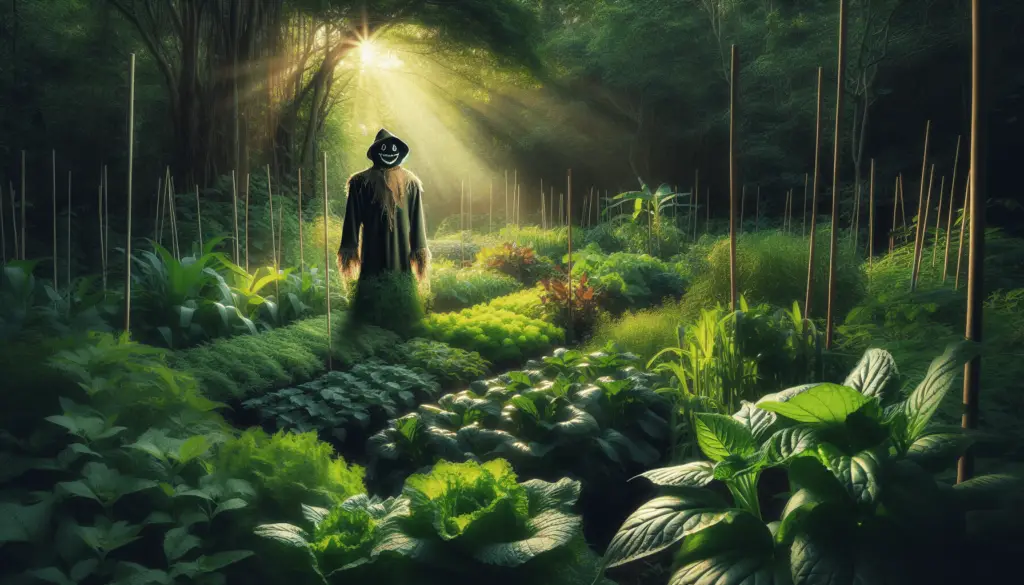Imagine being able to grow your own food and ensure your survival, even in the most challenging of circumstances. With an invisible survival garden, you can do just that. In this article, we will explore the key steps to creating your own invisible survival garden, a space that is discreet yet highly productive. By following these simple guidelines, you will be able to cultivate a thriving garden that will provide you with sustenance and security, without drawing unwanted attention. Get ready to unleash your green thumb and start your journey towards self-sustainability.

Choosing the Right Location
When it comes to creating an invisible survival garden, choosing the right location is essential. Assessing sunlight availability is the first step in determining the ideal spot for your garden. Look for an area that receives at least six hours of direct sunlight each day. This will ensure that your plants can thrive and produce an abundant harvest.
In addition to sunlight, evaluating soil quality is crucial. Conduct a soil test to determine its pH level and nutrient content. Ideally, the soil should be rich in organic matter and well-drained. If the soil is lacking in essential nutrients, consider adding compost or other organic amendments to improve its fertility.
Another factor to consider when choosing a location for your invisible garden is proximity to water sources. Reliable access to water is essential for the survival of your plants. Consider locating your garden near a water source such as a river, pond, or well. If this is not possible, make sure you have a water collection system in place to capture and store rainwater for irrigation purposes.
Selecting the Right Plants
Researching native plants is key to selecting the right plants for your invisible survival garden. Native plants are well-adapted to the local climate and soil conditions, making them more resilient and less prone to disease and pests. They also require less maintenance, making them an excellent choice for a low-profile garden.
When choosing plants, it is important to consider their maintenance requirements. Opt for plants that have minimal care needs, such as drought-tolerant varieties or those that are resistant to common pests and diseases. This will help reduce the amount of time and effort required to maintain your garden, allowing you to focus on other survival tasks.
Prioritizing plants with multiple uses is another smart strategy. Select plants that not only provide food but also have medicinal or other practical uses. This will maximize the benefits of your invisible garden and increase your self-sustainability in a survival scenario.
Creating Natural Barriers
Creating natural barriers around your invisible survival garden is essential to keep it discreet and hidden from prying eyes. Planting dense hedges or shrubs along the perimeter of your garden can provide effective camouflage. Choose varieties that are fast-growing and have thick foliage to create a barrier that is not easily seen through.
Tall grasses or reeds can also be used as camouflage for your garden. These plants can be strategically planted to create screens and conceal the garden from view. Additionally, building trellises for vertical gardening can help maximize space and provide additional cover for your plants.
By incorporating these natural barriers, you can create an invisible survival garden that blends seamlessly into its surroundings, increasing your chances of a successful harvest without drawing attention.
Implementing Clever Planting Techniques
Interspersing edible plants with non-edible plants is a smart planting technique for your invisible survival garden. By mixing in non-edible plants, you can create additional layers of camouflage and disguise the true purpose of your garden. This will make it less likely for others to identify your garden as a source of food.
Utilizing companion planting strategies for pest control is another clever technique. Some plants naturally repel pests, while others attract beneficial insects that prey on garden pests. By strategically interplanting these varieties, you can create a natural pest control system that helps protect your crops without the use of harmful chemicals.
Employing vertical gardening techniques is also beneficial in an invisible survival garden. By growing plants vertically, you can optimize space and increase your overall yield. This technique is especially useful in small or limited areas where horizontal gardening may not be feasible.

Tending to Your Invisible Garden
Once your invisible survival garden is established, proper care is crucial to ensure its success. Regularly watering and fertilizing your plants is essential, especially during dry periods. Monitor the moisture levels in the soil and adjust your watering schedule accordingly. Additionally, use organic fertilizers to replenish essential nutrients in the soil and promote healthy plant growth.
Mulching is another important maintenance task for your invisible garden. Apply a layer of mulch around the base of your plants to retain moisture, control weeds, and regulate soil temperature. This will help conserve water and reduce the need for frequent watering.
Pruning is also a necessary practice to maintain plant health and shape. Regularly remove any dead or diseased branches to prevent the spread of diseases and to promote better airflow within the garden. Additionally, pruning can help control the size and growth of your plants, ensuring they stay within the desired boundaries of your invisible garden.
Protecting Your Garden from Pests and Predators
Protecting your invisible survival garden from pests and predators is vital to ensure a productive harvest. Installing fencing or netting around the garden can deter larger animals from gaining access to your crops. Make sure the fencing or netting is secured tightly to prevent any gaps that animals could squeeze through.
Using natural pest control methods is preferable in a survival scenario. Companion planting, where certain plants are grown together to repel pests, can be an effective strategy. Additionally, planting trap crops can divert pests away from your main crops, sacrificing a small portion of your harvest to protect the rest.
Implementing scare tactics like reflective surfaces and noise devices can also help deter pests and predators. Hang shiny objects, such as aluminum foil or CD discs, around your garden to create reflections that scare away birds and other animals. Using noise devices like wind chimes or motion-activated sound devices can also startle pests and keep them at bay.
Harvesting and Preserving Your Yield
Knowing the ideal time to harvest each plant is crucial to maximize your yield. Harvesting too early or too late can result in a diminished quality of produce. Research the specific harvest times for each plant in your invisible garden and pay close attention to their appearance and taste.
Properly storing and preserving your harvested produce is essential for long-term food sustainability. Depending on the type of crop, different preservation methods can be utilized. Canning, drying, and fermenting are popular techniques that allow you to extend the shelf life of your harvested fruits and vegetables. Consider learning and practicing these preservation methods to ensure your food supply lasts as long as possible.
Growing Food in Stealthy Containers
Growing food in stealthy containers is an excellent option for those with limited outdoor space or living in urban areas. Disguised containers, such as self-watering planters or decorative pots, can blend seamlessly into balconies, patios, or even rooftops. These containers not only provide a practical solution for growing food but also help maintain the invisible nature of your survival garden.
Cultivating plants in small spaces like window boxes or hanging baskets is another effective way to grow food in stealthy containers. These compact options can be easily placed in inconspicuous locations, ensuring your invisible garden remains undetected.
Experimenting with indoor gardening techniques like hydroponics or aquaponics is also worth considering. These soil-less gardening methods allow you to grow a variety of plants indoors without requiring a large amount of space. By utilizing these techniques, you can grow fresh produce year-round, even in the most challenging environments.
Planning for Long-Term Sustainability
Planning for long-term sustainability is essential when creating an invisible survival garden. Saving seeds from your existing crops will allow you to replant them in future growing seasons, reducing the need to rely on external seed sources. Properly store the seeds in a cool, dry place to maintain their viability.
Implementing composting is another crucial step for long-term sustainability. Composting your kitchen scraps and garden waste will help improve the fertility of your soil, reducing the need for synthetic fertilizers. Creating a compost pile or using a compost bin in your invisible garden is an easy and effective way to recycle organic matter and produce nutrient-rich compost.
Creating a diverse and resilient ecosystem in your garden is also important for long-term sustainability. Incorporate a variety of plants that attract beneficial insects and birds. These natural predators can help control pests in your garden without the need for chemical interventions. By fostering a balanced ecosystem, you create a self-sustaining environment that requires minimal external inputs.
Sharing Knowledge and Resources
Sharing knowledge and resources with others is a valuable way to contribute to the wider community of self-sustainability. Joining local gardening groups or communities allows you to connect with like-minded individuals who share your passion for sustainable living. These groups often host workshops, garden tours, and seed exchanges, providing valuable opportunities to learn from experts and share your own experiences.
Participating in seed exchanges or sharing surplus produce is another way to contribute to the self-sustainability movement. By exchanging seeds with others, you can diversify your crop selection and help preserve heirloom varieties. Sharing surplus produce not only reduces food waste but also fosters a sense of community and collaboration.
Education plays a vital role in promoting self-sustainability. Share your knowledge and experiences with others, whether it’s through informal conversations with friends and family or by giving presentations and workshops. By educating others about the importance of self-sustainability and the benefits of creating invisible survival gardens, you can inspire and empower more individuals to embark on their own self-sufficiency journey.
Creating an invisible survival garden is not only a practical way to ensure a source of food in a survival scenario, but also a rewarding and fulfilling pursuit. By following these comprehensive guidelines and employing smart planting techniques, maintaining your invisible garden, and sharing resources and knowledge, you can create a self-sustainable oasis that thrives beneath the radar.
